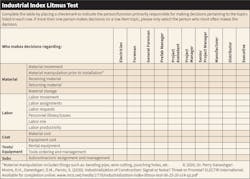Invisible Decisions — Part 2
MCA’s last Job-Site Intelligence column, published in the April 2021 issue of EC&M, examined the lack of visibility when it comes to job-related issues and decision-making in construction projects. The article summarized the extent of these issues, highlighting the findings from Dr. Heather Moore’s 2013 doctoral thesis, Exploring Information Generation and Propagation from the Point of Installation on Construction Jobsites, and pointing out that field personnel experience twice as many obstructions in performing their daily work as managers realize. In this article, we offer step-by-step guidelines for uncovering the hidden issues that kill job productivity and demoralize field personnel.
When problems arise on a job site, many contractors simply rely on field personnel to “make it work.” This can lead to frustration and poor project outcomes. On the other end of the spectrum — and less often in construction — companies sometimes adopt a behavior of micromanagement. Rather than educate personnel about which decisions can be made onsite, they promote a culture with a lack of autonomy in the field. This can also negatively affect the project as well as hinder communication flow between the office and the field.
How can you bring the concerns that your field personnel deal with daily to light? More specifically, how can you implement a proactive, standard approach to help field personnel escalate problems to upper management?
MCA’s 2020 research report (2020, ELECTRI International), “Industrialization of Construction: Signal or Noise? Threat or Promise?” addresses the current state of the construction industry. Its findings assert the need for contractors to assess their operations and prepare for the changes that will come because of industrialization. Specifically, the research suggests that a company’s decision-making structure is an indicator of their overall readiness to operate successfully in an industrialized environment and provides a practical, tested approach for companies to understand their current decision-making paradigm.
A critical piece in making any change in your company’s processes is to first understand how it currently functions. Once you have this process nailed down, you can make data-driven improvements to define the tasks that should be handled by a specific person in your company. The key is to provide field leaders and employees with clear expectations of the decisions they are responsible for making and which decisions need to be escalated to their project manager or upper-level management. In addition, your field leaders will have an idea of the time required for management resolution when they escalate an issue, which allows them to effectively plan and schedule work in the interim.
Using the following step-by-step guideline, you can quickly assess the current state of job decision-making in your company and begin making data-driven improvements.
Step 1: Reach out to your project teams.
This should include your foremen, project managers, project assistants, project executives, and anyone else who is part of your business’s project delivery process.
Step 2: Have them identify the person currently responsible for a series of job-related topics (e.g., material, labor, job costs, tools and equipment, and subcontractors).
This can be accomplished in minutes using MCA’s Industrialization Litmus Test (see the Table).
The test consists of 16 multiple-choice questions asking about the job function primarily responsible for decision-making for different elements of the job.
Step 3: Review the results.
Once the litmus test is complete, you will know:
- How many decisions are most often left to the responsibility of field personnel?
- Which position is currently responsible for making the most job-related decisions?
- Which types of decisions are most often made by which job function?
- Which decision-making model does your company most closely align with, and what does that mean for your company's overall readiness in terms of industrialization?
A sample of industrialization index litmus test results is displayed in the Figure.
By identifying which one of the curved areas on the graph has the greatest overlap with the bar chart results of your company, you can determine which of the three business models your company most closely aligns with (i.e., traditional, transitional, or professional).
- The traditional model is represented in the red area below the downward sloped curve. Traditional business models tend to leave most job-related decisions in the hands of electricians, foremen, and general foremen.
- The transitional model is represented in the yellow area under the upside-down U-shaped curve. Transitional businesses are in the process of shifting job-related decisions from field personnel to office personnel or management.
- The industrial/professional model is represented in the green area below the upward sloped curve. In this model, little-to-no decisions are managed in the field or even at the project-management level. Manufacturers, distributors, and executives are responsible for decision-making because the structure and decisions are pre-determined.
Step 4: Take action.
Using the results from the industrialization index litmus test, review which decisions are most often the responsibility of electricians, foremen, and general foremen. Determine if any opportunities exist to move these decisions upstream to project assistants or project managers, or if they can be handled by a distributor or manufacturing partners. This can help offload your field personnel, allowing them to better focus on efficient installation. If certain decisions (such as material movement) involve multiple personnel, identify why that is the case and if opportunities exist to reduce the number of people involved in the process.
Step 5: Communicate expectations.
Make your project teams and field personnel aware of which types of decisions and situations should be handled at which level in the organization — and which issues need to be escalated when they occur. Managing any job can come with several surprises and challenges. By assessing the current decision-making environment across your company, you can pinpoint the gaps in the information flow, and make data-driven improvements.
Dr. Perry Daneshgari is president and CEO of MCA, Inc., Grand Blanc, Mich. He can be reached at [email protected]. Sydney Parvin is assistant data analyst at MCA, Inc., Grand Blanc, Mich. She can be reached at [email protected].
About the Author
Sydney Parvin
Sydney Parvin is associate data analyst at MCA, Inc., Grand Blanc, Mich. She can be reached at [email protected].


